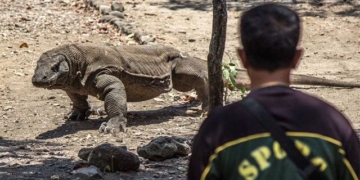Forget about the clear blue waters! The Earth is a miraculous planet. In Colombia, the Earth boasts a river of five colors. In Senegal, it proudly showcases Lac Rose, a vibrant pink lake…
Colorful Places Around the World
1. Caño Cristal (Colombia)
Caño Cristal is a natural river located in Sierra de La Macarena National Park, in the La Macarena region of Colombia. It is world-famous for its five colors: pink, red, yellow, orange, and green.
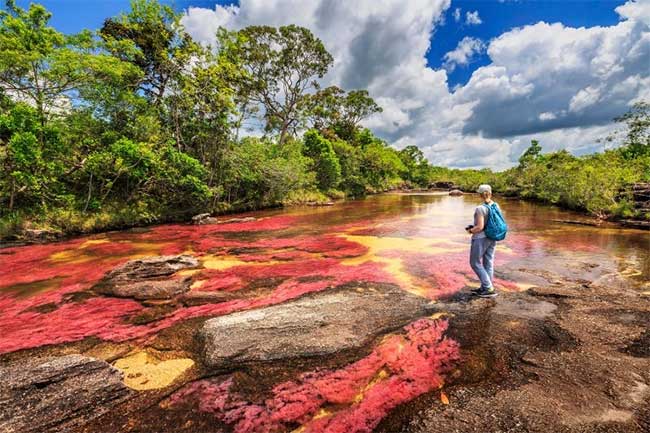
“The river that escaped from heaven” Caño Cristal.
The Caño Cristal originates from the ancient Guiana Shield, which is 1.7 billion years old, making it one of the oldest rock formations on the planet. It flows southward, winding its way through a 100 km cascade. Colombia experiences two seasons: the rainy season and the dry season. Throughout the rainy season, this South American country is soaked.
During the rainy season, Caño Cristal surges with turbulent, muddy waters, appearing as a fierce river. However, when the dry season arrives with bright sunshine, the water recedes, transforming it into the most beautiful river in the world.
The dry season in Colombia begins in June and lasts until November. The heat is so intense that the air seems to ignite. Without the sediment carried by the rainwater, Caño Cristal becomes crystal clear. The entire riverbed is covered with ancient rocks billions of years old, rich in phosphorus, iron, quartz, and more, creating an ideal environment for the growth of the Macarenia clavigera moss.
Macarenia clavigera is a moss endemic to the La Macarena area. Unlike typical aquatic plants, it changes color according to the intensity of sunlight. As the dry season sun becomes more intense and the water levels of Caño Cristal drop, the moss competes to change hues.
Even though they are the same type of moss, each patch “blooms” in a different color. Furthermore, Macarenia clavigera changes color randomly. Caño Cristal is always transforming. It is so beautiful that Colombians refer to it as the “river that escaped from heaven.”
2. Lac Rose (Senegal)
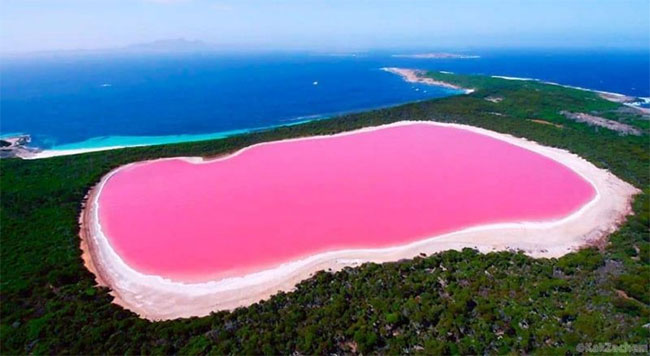
Lac Rose is most magnificent under the sun.
There is no place in the world more “heavenly” than Lac Rose (Pink Lake) on the Cap Vert Peninsula in Senegal. It is situated right next to the Atlantic Ocean, separated by a narrow strip of land, so close that a gentle wave can wash salty water into the lake.
True to its name, Lac Rose is a vivid pink. It stands out against the backdrop of lush greenery and the blue sea. The area of Lac Rose is about 3 km². As noon approaches, with temperatures soaring to 37°C, the sunlight becomes scorching and the dry winds intensify, making it even more vibrant. Similar to Caño Cristal, the color is caused by the presence of flora, specifically the red algae Dunaliella salina.
Dunaliella salina is one of the most common halophilic microalgae found worldwide. It has the ability to synthesize Beta-Carotene, a powerful organic sunscreen. This substance helps prevent sunburn, enhances photosynthesis, and imparts warm colors.
The hotter the weather, the more Dunaliella salina produces Beta-Carotene, turning the entire lake into a vibrant pink, reminiscent of strawberry milk.
The water in Lac Rose is ten times saltier than the Atlantic Ocean. This is a result of the lake receiving water, evaporating, and accumulating salt year after year.
3. Yuncheng (China)
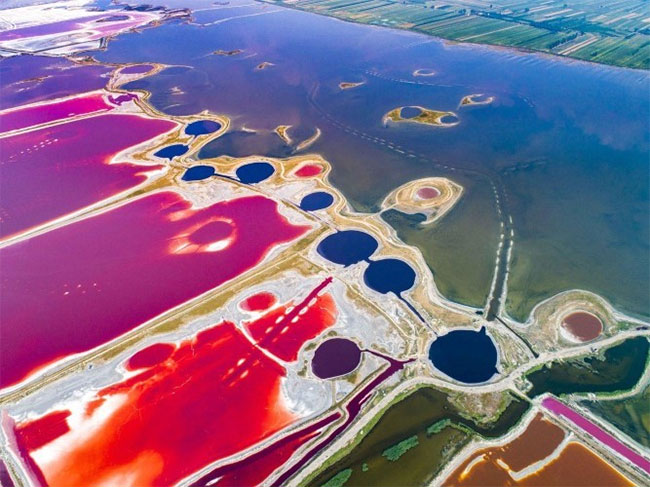
Yuncheng resembles a giant color palette.
Similar to Lac Rose, Yuncheng (Shanxi, China) is a salt lake. The difference is that it is divided into compartments, each possessing a different color. As summer arrives, layers of halophilic microalgae compete to produce Beta-Carotene, creating a multicolored Yuncheng that looks just like a giant color palette.
Of course, Yuncheng does not divide itself; it is divided by human intervention. Covering an area of 132 km², it has been partitioned into various large and small plots for convenient salt harvesting. The Han people have been exploiting the salt resources in the lake for about 6,000 years. In the 6th century, Yuncheng served as a major salt supplier, accounting for a quarter of China’s total salt production.
Today, Yuncheng remains one of the important salt-producing regions. Since 1980, it has transitioned to modern salt production techniques.
4. Dallol (Ethiopia)
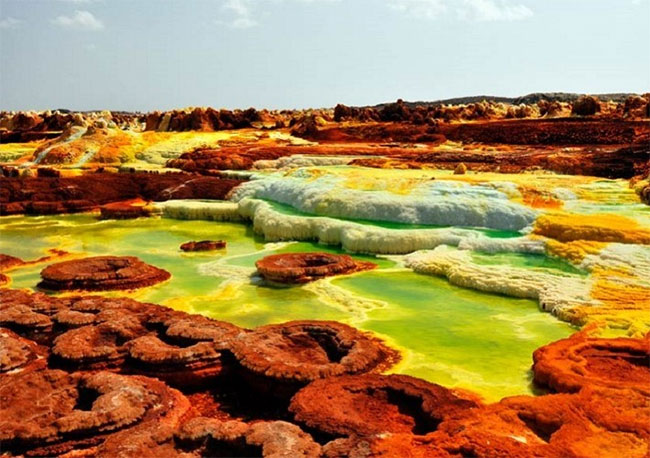
Dallol is beautiful yet extremely toxic, devoid of life.
Dallol is a barren area in the Afar Region of Ethiopia. It consists only of small pools of water, exhibiting a dazzling array of colors. However, the water here is not exactly water. While Caño Cristal, Lac Rose, and Yuncheng are living paradises, Dallol is truly a hell on Earth. All its pools are filled with concentrated acid, where even bacteria cannot survive.
The temperatures in Dallol are extremely high, consistently around 40°C, sometimes soaring to 73°C. Beneath these lifeless pools lies a boiling volcano. Standing on the ground here for even a moment can melt your shoes.
Remarkably, in this “gateway to hell”, the Afar people have discovered a rich source of life: salt. For thousands of years, Dallol salt has been the livelihood of the Afar people. Every night, when temperatures in the “gateway to hell” reach their lowest, the Afar light torches to guide them in collecting salt. They sell it to traders, earning extra income to improve their lives dependent on livestock.
5. Grand Prismatic (USA)
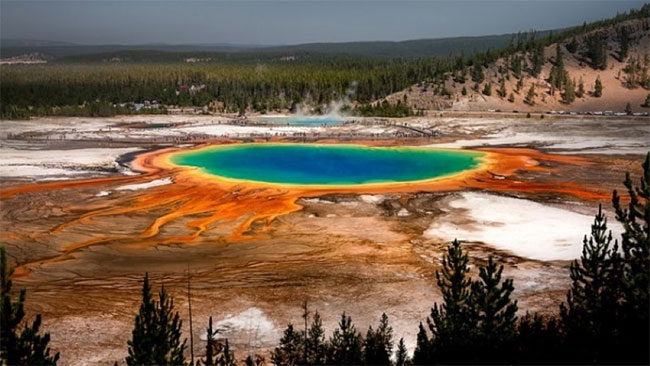
Grand Prismatic is scalding, yet teeming with thriving microalgae.
Grand Prismatic is a hot spring located in Yellowstone National Park, USA. It boils at 70°C, evaporating 2,100 liters of water per minute. Despite its boiling nature, the water in Grand Prismatic is rich in minerals, creating an ideal environment for many heat-loving microalgae to thrive.
The diameter of Grand Prismatic is about 110 meters, with a depth of 50 meters. Except for the extremely hot center, no microalgae can grow there; it is populated by microbial plants. These organisms display a variety of warm colors, with orange and yellow being the most common.
Like most vibrant waters due to moss and algae, Grand Prismatic is also incredibly stunning in the summer. The sunlight and the boiling water cause the microbial plants to produce natural protective substances at full capacity. The green hues disappear, replaced by bright, dazzling colors that challenge the scorching sun.




















































